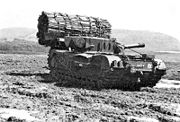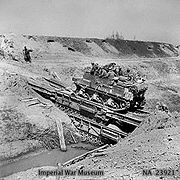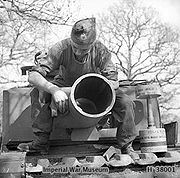
Armoured Vehicle Royal Engineers
Encyclopedia

Royal Engineers
The Corps of Royal Engineers, usually just called the Royal Engineers , and commonly known as the Sappers, is one of the corps of the British Army....
(RE) for the purpose of battlefield engineer support. These vehicles have been either purpose-built or post-production modifications of existing tank-based armoured vehicles. A common feature of most AVREs to date has been the retention of a large calibre main gun
Tank gun
A tank gun is the main armament of a tank. Modern tank guns are large-caliber high-velocity guns, capable of firing kinetic energy penetrators, high explosive anti-tank rounds, and in some cases guided missiles. Anti-aircraft guns can also be mounted to tanks.-Overview:Tank guns are a specific...
or the addition of a larger calibre weapon. The most recent vehicle to be called an AVRE is the Challenger-based Trojan; however this vehicle breaks the trend by not having a large calibre weapon. With the multitude of functions now required of the RE, new vehicles have come into use which are given alternative names, but which are to all intents and purposes, AVREs.
World War One
The first vehicle that can be considered to be an AVRE is the Heavy RE tank developed shortly after World War IWorld War I
World War I , which was predominantly called the World War or the Great War from its occurrence until 1939, and the First World War or World War I thereafter, was a major war centred in Europe that began on 28 July 1914 and lasted until 11 November 1918...
by Major Giffard LeQuesne Martel
Giffard LeQuesne Martel
General Sir Giffard Le Quesne Martel, KCB, KBE, DSO, MC , familiarly known as "Q Martel", was a British Army officer during World War I and World War II....
RE. This vehicle was a modified Mark V
Mark I tank
The British Mark I was a tracked vehicle developed by the British Army during the First World War and the world's first combat tank. The Mark I entered service in August 1916, and was first used in action on the morning of 15 September 1916 during the Battle of Flers-Courcelette, of the Somme...
tank.
Two support functions for these AVREs were developed - bridging and mine clearance. The bridging component involved an assault bridge, designed by Major Charles Inglis
Charles Inglis (engineer)
Sir Charles Edward Inglis OBE was a British civil engineer. Inglis spent much of his life as a lecturer and academic at King's College Cambridge and made several important studies into the effects of vibration and defects on the strength of plate steel...
RE, called the Canal Lock Bridge, which had sufficient length to span a canal lock. Major Martel mated the bridge with the tank and used hydraulic power
Fluid power
Fluid power is the use of fluids under pressure to generate, control, and transmit power. Fluid power is subdivided into hydraulics using a liquid such as mineral oil or water, and pneumatics using a gas such as air or other gases...
generated by the tank's engine to manoeuvre the bridge into place. For mine clearance the tanks were equipped with 2 ton rollers
Mine roller
A mine roller or mine trawl is a demining device mounted on a tank or armoured personnel carrier, designed to detonate anti-tank mines. It allows engineers to clear a lane through a minefield which is protected by enemy fire....
.

Between The Wars
Between the wars various experimental bridging tanks were used to test a series of methods for bridging obstacles and developed by the Experimental Bridging Establishment (EBE).Captain SG Galpin RE conceived a prototype Light Tank Mk V to test the Scissors Assault Bridge. This concept was realised by Captain SA Stewart RE with significant input from a Mr DM Delany, a scientific civil servant in the employ of the EBE.
MB Wild & Co, Birmingham, also developed a bridge that could span gaps of 26 feet using a complex system of steel wire ropes and a travelling jib, where the front section was projected and then attached to the rear section prior to launching the bridge. This system had to be abandoned due to lack of success in getting it to work, however the idea was later used successfully on the Beaver Bridge Laying Tank.
World War Two
Once World War Two had begun the development of armoured vehicles for use by engineers in the field was accelerated under Delaney's direction. The EBE rapidly developed an assault bridge carried on a modified CovenanterCovenanter tank
The Tank, Cruiser, Mk V, Covenanter was a British Cruiser tank of the Second World War. It was named for the Covenanters, a Scottish religious faction in the British Isles at the time of the Wars of the Three Kingdoms...
tank capable of deploying a 24 ton tracked load capacity bridge (Class 24) that could span gaps of 30 feet. However, it did not see service in the British armed forces and all vehicles were passed onto allied forces such as Australia and Czechoslovakia.
A Class 30 design superseded the Class 24 with no real re-design, simply the substitution of the Covenanter tank with a suitably modified Valentine
Valentine tank
The Tank, Infantry, Mk III, Valentine was an infantry tank produced in the United Kingdom during the Second World War. More than 8,000 of the type were produced in 11 different marks plus various purpose-built variants, accounting for approximately a quarter of wartime British tank production...
.
As tanks in the war got heavier a new bridge capable of supporting them was developed. A heavily modified Churchill
Churchill tank
The Tank, Infantry, Mk IV was a heavy British infantry tank used in the Second World War, best known for its heavy armour, large longitudinal chassis with all-around tracks with multiple bogies, and its use as the basis of many specialist vehicles. It was one of the heaviest Allied tanks of the war...
used a single-piece bridge mounted on a turret-less tank and was able to lay the bridge in 90 seconds; this bridge was able to carry a 60 ton tracked or 40 ton wheeled load.
The first bridge to equip an AVRE Churchill was the Tank Bridge, Box Girder. This equipment bridged gaps of 30 feet, but could also be used to cross 12 foot seawalls or other similar obstacles.
The Churchill ARK (Armoured Ramp Carrier) was a flexible design, where the tank itself was the "bridge". Multiple vehicles could be used to span gaps in both the vertical and horizontal. The tank had the turret removed and trackways fitted to the hull. Ramps were attached at each end of the trackways extending the bridging potential and allowing its use in difficult terrain. The tank would need recovery after its use was no longer required.
List of AVRE vehicles deployed

Mark I tank
The British Mark I was a tracked vehicle developed by the British Army during the First World War and the world's first combat tank. The Mark I entered service in August 1916, and was first used in action on the morning of 15 September 1916 during the Battle of Flers-Courcelette, of the Somme...
Heavy RE tank variants:
- Bridgelayer, a Mark V tank, with canal lock bridge
- Mine clearer, a Mark V tank, with mine rollers
Light Tank Mk V
- Bridgelayer, scissors assault bridge
Covenanter tank
Covenanter tank
The Tank, Cruiser, Mk V, Covenanter was a British Cruiser tank of the Second World War. It was named for the Covenanters, a Scottish religious faction in the British Isles at the time of the Wars of the Three Kingdoms...
- Bridgelayer, deploying a Class 24 scissors bridge
Valentine tank
Valentine tank
The Tank, Infantry, Mk III, Valentine was an infantry tank produced in the United Kingdom during the Second World War. More than 8,000 of the type were produced in 11 different marks plus various purpose-built variants, accounting for approximately a quarter of wartime British tank production...
- Valentine Mk II, deploying a Class 30 scissors bridge

- Was a Churchill Mk III armed with a 290 mm Petard Spigot mortar, its turret was of welded construction
- A Churchill Mk IV, which had a cast turret. Post-war, the Churchill AVRE was re-armed with a short barrelled L9A1 165 mm demolition gun which fired a 64 lb (29 kg) HESH round
Centurion tank
Centurion tank
The Centurion, introduced in 1945, was the primary British main battle tank of the post-World War II period. It was a successful tank design, with upgrades, for many decades...
variants:
- FV4003 Centurion Mk 5 AVRE. Armed with a short barrelled L9A1 165 mm demolition gun, it entered service in 1963, replacing the Churchill AVRE
- FV4203 Centurion Mk 12 AVRE. A modified Artillery Observation Post vehicle, it was armed with the conventional 105 mm Royal Ordnance L7Royal Ordnance L7The Royal Ordnance L7 is the basic model of Britain's most successful tank gun. The L7 was a 105 mm L/52 rifled design intended for use in armoured fighting vehicles...
rifled gun
Chieftain tank
Chieftain tank
The FV 4201 Chieftain was the main battle tank of the United Kingdom during the 1960s and 1970s. It was one of the most advanced tanks of its era, and at the time of its introduction in 1966 had the most powerful main gun and heaviest armour of any tank in the world...
variants:
- The WillichWillichWillich is a town in the district of Viersen, in North Rhine-Westphalia, Germany. It is located near the cities of Düsseldorf, Mönchengladbach and Krefeld, about 30 kilometres from the border with the Netherlands.-History:...
Chieftain AVRE entered service in 1987. This vehicle was designed by Capt D Clegg MBE RE. The vehicle was built by 32 Armoured Engineer Regiment and 21 Engineer Base Workshop of the Royal EngineersRoyal EngineersThe Corps of Royal Engineers, usually just called the Royal Engineers , and commonly known as the Sappers, is one of the corps of the British Army....
under the direction of Lt Col JF Johnson RE based in the German town of Willich, hence its name - The Chieftain AVRE entered service in 1994. 48 units were produced by Vickers Defence Systems
FV180 Combat Engineer Tractor
FV180 Combat Engineer Tractor
The FV180 Combat Engineer Tractor or C.E.T. is an amphibious specialist armoured vehicle of the British Army and has been in general service since 1976...
(CET)
- 143 units were supplied, it entered service in 1977
Warrior IFV
Warrior Tracked Armoured Vehicle
The Warrior tracked vehicle family is a series of British armoured vehicles, originally developed to replace the older FV430 series of armoured vehicles. The Warrior started life as the MCV-80 project that was first broached in the 1970s, GKN Sankey/Defence winning the production contract in 1980....
variants,:
- FV512 Mechanised Combat Repair Vehicle, 105 units supplied
- FV513 Mechanised Recovery Vehicle, 39 units supplied (Special note: As of 2004, all Warrior units operating in Iraq have additional Bar ArmourCage armorSlat armor is a type of vehicle armor designed to protect against anti-tank rocket-propelled grenade attacks...
added)
Shielder
Alvis Stormer
Alvis Stormer is a modern military armoured vehicle manufactured by the British company, Alvis Vickers, now BAE Systems Global Combat Systems....
Vehicle Launched Scatterable Mine System
- Essentially a modified BAE Systems Land Systems StormerAlvis StormerAlvis Stormer is a modern military armoured vehicle manufactured by the British company, Alvis Vickers, now BAE Systems Global Combat Systems....
with the Alliant TechsystemsAlliant TechsystemsAlliant Techsystems Inc., most commonly known by its ticker symbol, ', is one of the largest aerospace and defense companies in the United States with more than 18,000 employees in 22 states, Puerto Rico and internationally, and 2010 revenues in excess of an estimated...
Volcano mine delivery system, 30 have been delivered
Challenger variants:
- Challenger Armoured Repair and Recovery Vehicle, 81 units supplied
- Trojan Combat Engineer Vehicle (CEV), based on the Challenger 2 chassis, the Trojan will be equipped with an articulated excavator arm, a dozer blade and rails for fascines. 33 units have been ordered from BAE Systems Land Systems
- Titan AVLB, also based on the Challenger 2 chassis, the Titan Armoured Vehicle Launched Bridge, 33 units have been ordered from BAE Land Systems
Terrier
Terrier vehicle
The Terrier vehicle is an air-transportable armoured combat engineer vehicle for the Royal Engineers. It is being developed as a replacement vehicle for the FV180 Combat Engineer Tractor used by the British Army....
CET
- Currently in development to replace the FV180. Substantial use of Commercial off-the-shelfCommercial off-the-shelfIn the United States, Commercially available Off-The-Shelf is a Federal Acquisition Regulation term defining a nondevelopmental item of supply that is both commercial and sold in substantial quantities in the commercial marketplace, and that can be procured or utilized under government contract...
parts is part of the design of the vehicle, including a CaterpillarCaterpillar Inc.Caterpillar Inc. , also known as "CAT", designs, manufactures, markets and sells machinery and engines and sells financial products and insurance to customers via a worldwide dealer network. Caterpillar is the world's largest manufacturer of construction and mining equipment, diesel and natural gas...
drive train (C18 diesel engine and an X300 series automatic transmission) and excavator. It also uses the alloy road wheels from the BAE SystemsBAE SystemsBAE Systems plc is a British multinational defence, security and aerospace company headquartered in London, United Kingdom, that has global interests, particularly in North America through its subsidiary BAE Systems Inc. BAE is among the world's largest military contractors; in 2009 it was the...
Combat Vehicle 90Combat Vehicle 90The Combat Vehicle 90 or Stridsfordon 90 is a Swedish infantry fighting vehicle designed by Hägglunds where the first generation was fitted with a Bofors turret. It is currently produced by BAE Systems Hägglunds.-Background:...
programme. The Terrier is armoured using steel rather than the aluminium alloy of its predecessor
See also
- Hobart's FunniesHobart's FunniesHobart's Funnies were a number of unusually modified tanks operated during World War II by the United Kingdom's 79th Armoured Division or by specialists from the Royal Engineers. They were designed in light of problems that more standard tanks experienced during the Dieppe Raid, so that the new...
, a group of unusually modified tanks from the Second World War, some of which were also AVREs.
External links
- http://www.remuseum.org.uk/index.htm
- http://www2.army.mod.uk/royalengineers/org/re_armdwing/dmschool.htm
- http://jdw.janes.com/public/adlink/ads/1185554.pdf
- http://www.army.mod.uk/equipment/engineering/1490.aspx

